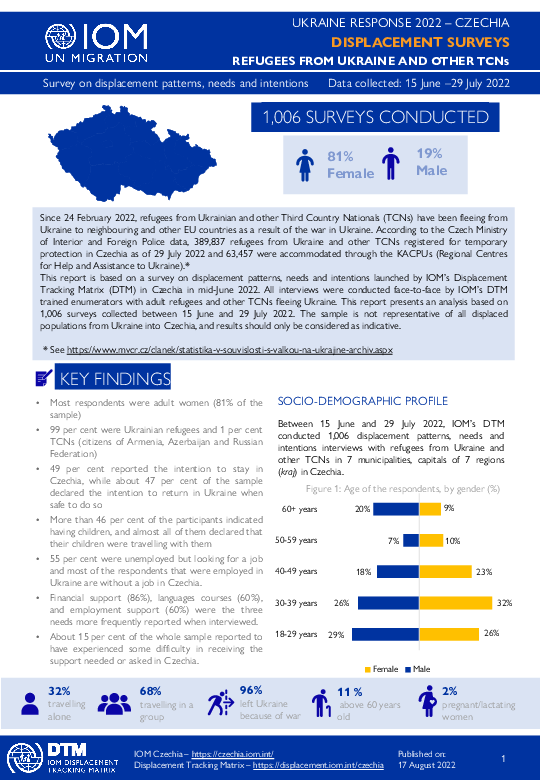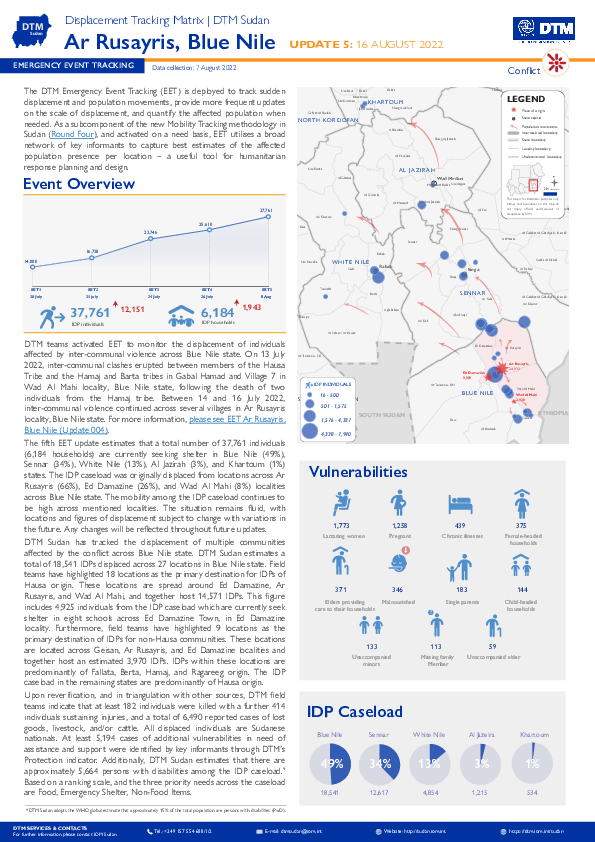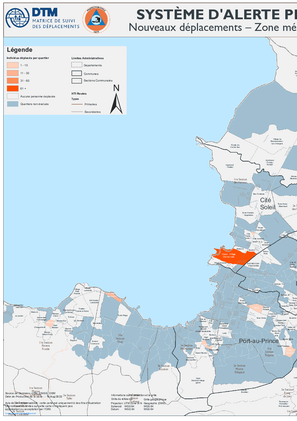-
Countries
-
Data and Analysis
-
Special Focus
-
Crisis Responses
Carte des Nouvelles arrivées des PDI dans la zone métropolitaine de Port-au-Prince, du 30 juillet - 05 août 2022.
Carte des nouveaux déplacements – Zone métropolitaine de Port-au-Prince – 30 juillet - 05 août 2022.

Contact
DTM Mali, DTMMali@iom.int
Language
English
Location
Mali
Period Covered
Jul 01 2022
Jul 31 2022
Activity
- Flow Monitoring
In order to gain a better understanding of mobility flows and trends, the International Organization for Migration (IOM) has implemented the Displacement Tracking Matrix’s Flow Monitoring (FM) tool at key transit points across the region. Flow Monitoring activities are conducted in close cooperation with national and local authorities as well as local partners. The Flow Monitoring tool consists of two main components: the Flow Monitoring Registry (FMR), which captures key data on the volume, origin, destination and mode of travel of mobility flows, and the Flow Monitoring Survey (FMS), individual surveys conducted with travellers to gather detailed information about the profiles, migration experience and intentions of migrants. Through these activities, the Flow Monitoring tool collects data on migration flows and trends, traveller profiles, migration journeys, and intentions of migrants, so as to obtain a better understanding of mobility.
In Mali, DTM conducts Flow Monitoring activities at seven Flow Monitoring Points (FMPs) located across six regions, in order to foster a better understanding of the numbers, trends, profiles, and journeys of migration flows crossing these points.
This reports presents data collected through the Flow Monitoring Registry in July 2022.

Contact
DTM Mali, DTMMali@iom.int
Language
French
Location
Mali
Period Covered
Jul 01 2022
Jul 31 2022
Activity
- Flow Monitoring
Afin de mieux comprendre les mouvements et tendances migratoires, l’OIM, à travers la Matrice de suivi des déplacements (Displacement Tracking Matrix, DTM), met en œuvre l’activité de Suivi des flux de populations (Flow Monitoring, FM).
Le suivi des flux, qui est mis en œuvre en étroite collaboration avec les autorités et des partenaires nationaux et locaux, est composé de deux outils: l’enregistrement des flux (Flow Monitoring Registry, FMR), qui recueille des données clés sur l’ampleur, la provenance, la destination et les modalités des flux de mobilité, et les enquêtes individuelles (Flow Monitoring Survey, FMS), conduites auprès des voyageurs afin d’obtenir des informations sur les profils, parcours migratoires, et intentions des migrants. Le suivi des flux de populations récolte ainsi des données sur les flux et tendances migratoires, les profils des voyageurs et les parcours et intentions des migrants, afin de fournir une meilleure compréhension des mobilités.
Au Mali, la DTM recueille des données au niveau de 7 Points de suivi des flux (Flow Monitoring Points, FMP), répartis dans 6 régions afin d’obtenir une meilleure compréhension de l’ampleur, des tendances, des caractéristiques socio-démographiques et des parcours des flux de voyageurs traversant ces différents points.
Ce rapport présente les données recueillies dans le cadre des activités d’enregistrement des flux durant le mois de juillet 2022.

Contact
DTM Europe, DTMMediterranean@iom.int
Language
English
Location
Czechia
Period Covered
Jun 15 2022
Jul 29 2022
Activity
- Survey
- Flow Monitoring
Since 24 February 2022, refugees from Ukrainian and other Third Country Nationals (TCNs) have been fleeing from Ukraine to neighbouring and other EU countries as a result of the war in Ukraine. According to the Czech Ministry of Interior and Foreign Police data, 389,837 refugees from Ukraine and other TCNs registered for temporary protection in Czechia as of 29 July 2022 and 63,457 were accommodated through the KACPUs (Regional Centres for Help and Assistance to Ukraine).*
This report is based on a survey on displacement patterns, needs and intentions launched by IOM’s Displacement Tracking Matrix (DTM) in Czechia in mid-June 2022. All interviews were conducted face-to-face by IOM’s DTM trained enumerators with adult refugees and other TCNs fleeing Ukraine. This report presents an analysis based on 1,006 surveys collected between 15 June and 29 July 2022. The sample is not representative of all displaced populations from Ukraine into Czechia, and results should only be considered as indicative.
* See https://www.mvcr.cz/clanek/statistika-v-souvislosti-s-valkou-na-ukrajine-archiv.aspx

Contact
DTM Europe, DTMMediterranean@iom.int
Language
English
Location
Slovakia
Period Covered
Apr 19 2022
Jul 31 2022
Activity
- Survey
- Return Intention
Since 24 February 2022, an increasing number of refugees from Ukraine and other third-country nationals (TCNs) entering Slovakia has been registered as a result of the war in Ukraine. As of 9 August, Slovak authorities have reported 668,195 border crossings from Ukraine, out of whom 95 per cent were reported to be refugees from Ukraine and 5 per cent other (TCNs). At the same time, 401,945 border crossings to Ukraine have been reported since 28 February 2022 (UNHCR).
This report is based on a survey launched by IOM’s Displacement Tracking Matrix (DTM) with persons crossings to Ukraine from Slovakia since mid-April, and presents an analysis based on 185 surveys collected between 19 April and 31 July 2022 by IOM Slovakia trained enumerators. Individuals crossing into Ukraine are not necessarily returnees and conclusions on definitive trends cannot be drawn. The sample is not representative of all persons crossing to Ukraine, and results should only be considered as indicative.

Contact
DTM Mali, DTMMali@iom.int
Language
French
Location
Mali
Period Covered
Apr 01 2022
Jun 30 2022
Activity
- Survey
- Flow Monitoring Survey
- Flow Monitoring
Ce rapport met en exergue les principaux résultats issus de l’enregistrement de flux de migrants et des enquêtes individuelles effectués par la DTM auprès des migrants transitant aux différents points de suivi de flux (FMP) du Mali au cours du second trimestre de l’année 2022.
Les différents résultats témoignent du fait que le Mali soit l’une des principales routes empruntées par les migrants en Afrique de l’Ouest. En effet, la diversité des nationalités observées (23 nationalités), des routes empruntées, des pays de provenance et de destination, démontrent la place prépondérante qu’occupe le Mali dans les mobilités en Afrique de l’Ouest et du Centre.
Les problématiques de la traite des personnes, du trafic illicite de migrants, de vulnérabilités, ainsi que l’insécurité observée de jour en jour sur les routes migratoires, auxquelles sont exposées les migrants restent des facteurs sur lesquels peu d’information sont fournies. La forme d’exploitation observée au cours de ce trimestre était le travail forcé des migrants sur la route migratoire.
Europe First Arrivals Map - Jan-Jun 2022
Europe Migrant Presence Overview Map - as of end of June 2022
Contact
DTM Burundi, DTMBurundi@iom.int
Location
Burundi
Activity
- Mobility Tracking
- Site Assessment
Period Covered
Apr 11 2022 -May 03 2022
A site assessment is a sub-component of mobility tracking. It aims to collect data on population presence, living conditions and needs in a particular displacement site or community.
Population Groups
Survey Methodology
Unit of Analysis Or Observation
Type of Survey or Assessment
Keywords
Geographical Scope
Administrative boundaries with available data
The current dataset covers the following administrative boundaries

Contact
DTM Sudan; dtmsudan@iom.int
Language
English
Location
Sudan
Snapshot Date
Aug 07 2022
Activity
- Mobility Tracking
- Event Tracking
The DTM Emergency Event Tracking (EET) is deployed to track sudden displacement and population movements, provide more frequent updates on the scale of displacement, and quantify the affected population when needed. As a subcomponent of the new Mobility Tracking methodology in Sudan (Round Four), and activated on a need basis, EET utilises a broad network of key informants to capture best estimates of the affected population presence per location – a useful tool for humanitarian response planning and design.



